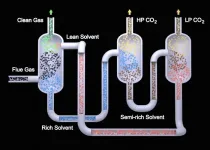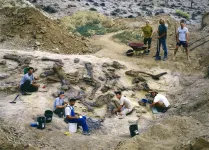(Press-News.org) A team led by Christoph Utschick and Prof. Rudolf Gross, physicists at the Technical University of Munich (TUM), has developed a coil with superconducting wires capable of transmitting power in the range of more than five kilowatts contactless and with only small losses. The wide field of conceivable applications include autonomous industrial robots, medical equipment, vehicles and even aircraft.
Contactless power transmission has already established itself as a key technology when it comes to charging small devices such as mobile telephones and electric toothbrushes. Users would also like to see contactless charging made available for larger electric machines such as industrial robots, medical equipment and electric vehicles.
Such devices could be placed on a charging station whenever they are not in use. This would make it possible to effectively utilize even short idle times to recharge their batteries. However, the currently available transmission systems for high performance recharging in the kilowatt range and above are large and heavy, since they are based on copper coils.
Working in a research partnership with the companies Würth Elektronik eiSos and superconductor coating specialist Theva Dünnschichttechnik, a team of physicists led by Christoph Utschick and Rudolf Gross have succeeded in creating a coil with superconducting wires capable of contactless power transmission in the order of more than five kilowatts (kW) and without significant loss.
Reduced alternating current loss in superconductors
This meant the researchers had to overcome a challenge. Minor alternating current losses also occur in superconducting transmission coils. These losses grow as transmission performance increases, with a decisive impact: The surface temperature of the superconducting wires rises and the superconduction collapses.
The researchers developed a special coil design in which the individual windings of the coil are separated from one another by spacers. "This trick significantly reduces alternating current loss in the coil," says Christoph Utschick. "As a result, power transmission as high as the kilowatt range is possible."
Optimization with analytical and numerical simulations
The team chose a coil diameter for their prototype that resulted in a higher power density than is possible in commercially available systems. "The basic idea with superconducting coils is to achieve the lowest possible alternating current resistance within the smallest possible winding space and thus to compensate for the reduced geometric coupling," says Utschick.
This called on the researchers to resolve a fundamental conflict. If they made the distance between the windings of the superconducting coil small, the coil would be very compact, but there would be a danger of superconduction collapse during operation. Larger separations would on the other hand result in lower power density.
"We optimized the distance between the individual windings using analytical and numerical simulations," says Utschick. "The separation is approximately equal to half the width of the tape conductor." The researchers now want to work on further increasing the amount of transmittable power.
Exciting application areas
If they succeed, the door will open to a large number of very interesting application areas, for example uses in industrial robotics, autonomous transport vehicles and high-tech medical equipment. Utschick even envisions electric racing vehicles which can be charged dynamically while on the race track, as well as autonomous electric aircraft.
Wide-scale applicability of the system still faces an obstacle, however. The coils require constant cooling with liquid nitrogen, and the cooling vessels used cannot be made of metal. The walls of metal vessels would otherwise heat up considerably in the magnetic field, much as a pot does on an induction stove.
"There is as yet no cryostat like this which is commercially available. This will mean an extensive amount of further development effort," says Rudolf Gross, Professor for Technical Physics at the Technical University of Munich and Director of the Walther-Meissner-Institute of the Bavarian Academy of Sciences and Humanities. "But the achievements up to now represent major progress for contactless power transmission at high power levels."
INFORMATION:
Cooperation partner Würth Elektronik eiSos defined the topic and financed the industrial promotion underlying this publication. Essential parts of the research were conducted at the Walther-Meissner-Institute (WMI) of the Bavarian Academy of Sciences and Humanities. The high-temperature superconductors used were provided by Theva Dünnschichttechnik, a spin-off company of the Technical University of Munich.
Publication:
Christoph Utschick, Cem Som, Ján Souc, Veit Große, Fedor Gömöry and Rudolf Gross
Superconducting Wireless Power Transfer Beyond 5 kW at High Power Density for Industrial Applications and Fast Battery Charging.
IEEE Transactions on Applied Superconductivity, 2. Februar 2021 - DOI: 10.1109/TASC.2021.3056195
How do you turn "dumb" headphones into smart ones? Rutgers engineers have invented a cheap and easy way by transforming headphones into sensors that can be plugged into smartphones, identify their users, monitor their heart rates and perform other services.
Their invention, called END ...
Irvine, Calif., March 11, 2021 - Catastrophic collapse of materials and structures is the inevitable consequence of a chain reaction of locally confined damage - from solid ceramics that snap after the development of a small crack to metal space trusses that give way after the warping of a single strut.
In a study published this week in Advanced Materials, engineers at the University of California, Irvine and the Georgia Institute of Technology describe the creation of a new class of mechanical metamaterials that delocalize deformations to prevent failure. They did so by turning to tensegrity, a century-old design principle in which isolated ...
LAWRENCE -- Much like coronavirus, circulating HIV-1 viruses mutate into diverse variants that pose challenges for scientists developing vaccines to protect people from HIV/AIDS.
"AIDS vaccine development has been a decades-long challenge partly because our immune systems have difficulty recognizing all the diverse variants of the rapidly mutating HIV virus, which is the cause of AIDS," said Brandon DeKosky, assistant professor of pharmaceutical chemistry and chemical & petroleum engineering at the University of Kansas.
In the past five years, tremendous progress has been ...
Philadelphia, March 12, 2021 - Researchers from Children's Hospital of Philadelphia (CHOP) have determined what happens at a cellular level as the lung alveolus forms and allows newborns to breathe air. Understanding this process gives researchers a better sense of how to develop therapies and potentially regenerate this critical tissue in the event of injury. The findings were published online today by the journal Science.
The lung develops during both embryonic and postnatal stages, during which lung tissue forms and a variety of cell types perform specific roles. During the transition from embryo to newborn is when the alveolar region of the lung ...
Skoltech researchers were able to show that patterns that can cause neural networks to make mistakes in recognizing images are, in effect, akin to Turing patterns found all over the natural world. In the future, this result can be used to design defenses for pattern recognition systems currently vulnerable to attacks. The paper, available as an arXiv preprint, was presented at the 35th AAAI Conference on Artificial Intelligence (AAAI-21).
Deep neural networks, smart and adept at image recognition and classification as they already are, can still be vulnerable ...
An enzyme called MARK2 has been identified as a key stress-response switch in cells in a study by researchers at Johns Hopkins Bloomberg School of Public Health. Overactivation of this type of stress response is a possible cause of injury to brain cells in neurodegenerative diseases such as Alzheimer's, Parkinson's, and Amyotrophic Lateral Sclerosis. The discovery will make MARK2 a focus of investigation for its possible role in these diseases, and may ultimately be a target for neurodegenerative disease treatments.
In addition to its potential relevance to neurodegenerative diseases, the finding is an advance in understanding basic cell biology.
The paper describing ...
RICHLAND, Wash.--As part of a marathon research effort to lower the cost of carbon capture, chemists have now demonstrated a method to seize carbon dioxide (CO2) that reduces costs by 19 percent compared to current commercial technology. The new technology requires 17 percent less energy to accomplish the same task as its commercial counterparts, surpassing barriers that have kept other forms of carbon capture from widespread industrial use. And it can be easily applied in existing capture systems.
In a study published in the March 2021 edition of International Journal of Greenhouse Gas Control, researchers from the U.S. Department of Energy's Pacific Northwest National Laboratory--along with collaborators from ...
MADISON, Wis. -- Mexican wolves in the American Southwest disappeared more quickly during periods of relaxed legal protections, almost certainly succumbing to poaching, according to new research published Wednesday.
Scientists from the University of Wisconsin-Madison found that Mexican wolves were 121% more likely to disappear -- despite high levels of monitoring through radio collars -- when legal rulings permitted easier lethal and non-lethal removal of the protected wolves between 1998 and 2016. The disappearances were not due to legal removal, the researchers say, but instead were likely caused by poachers hiding evidence of their activities.
The findings suggest that consistently strong protections for endangered predators lead ...
Fossil sites sometimes resemble a living room table on which half a dozen different jigsaw puzzles have been dumped: It is often difficult to say which bone belongs to which animal. Together with colleagues from Switzerland, researchers from the University of Bonn have now presented a method that allows a more certain answer to this question. Their results are published in the journal Palaeontologia Electronica.
Fossilized dinosaur bones are relatively rare. But if any are found, it is often in large quantities. "Many sites contain the remains of dozens of animals," explains Prof. Dr. Martin Sander from the Institute ...
For the first time ever, a Northwestern University-led research team has peered inside a human cell to view a multi-subunit machine responsible for regulating gene expression.
Called the Mediator-bound pre-initiation complex (Med-PIC), the structure is a key player in determining which genes are activated and which are suppressed. Mediator helps position the rest of the complex -- RNA polymerase II and the general transcription factors -- at the beginning of genes that the cell wants to transcribe.
The researchers visualized the complex in high resolution using cryogenic electron microscopy (cryo-EM), ...





